An occasional series in which editor Vince Bottomley and others explore their favorite wildcat cartridges that may appeal to target shooters.
Last time, in this series, we had a look at the 6mm Smack – an improved version of the 6mm Swiss Match. I love the little Smack – it’s a great all-rounder – effective in 600 and 1000 yard benchrest competition and a decent F Class performer as well, particularly out to 800 yards. Yes, it will perform at greater distances but the Smack’s tiny 6mm bullets will get ‘kicked’ in slow-fire F Class competition – unless it’s a calm day.
If the Smack has a drawback, it’s case-forming and lack of ‘off the shelf’ reloading dies. For this reason, I’m anxious to explore just how its close relation – the Tubb 6XC – compares. OK, maybe the 6XC is no longer a true ‘wildcat’ – as often happens, when a cartridge is this good, a manufacturer takes an interest and ‘tames’ the wildcat – which means that we can now buy 6XC brass from Norma.
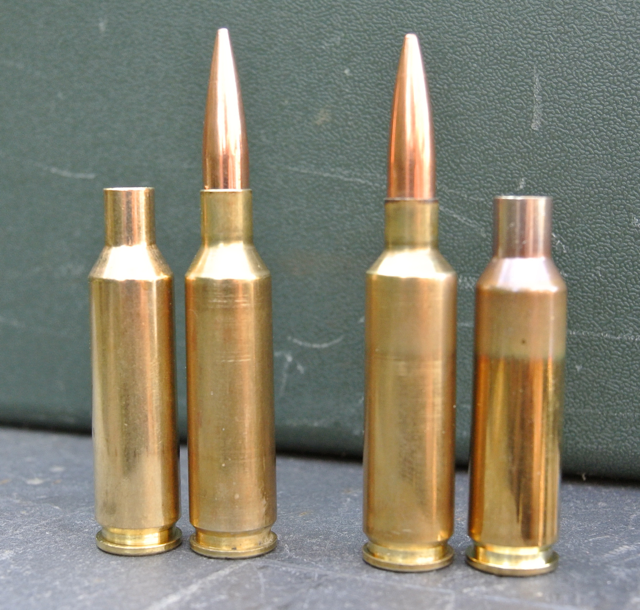
Whereas the Smack very much remains a wildcat, the 6XC has now assumed ‘factory’ status, though the 6XC’s genes lie firmly in the 22-250 case. Norma can even supply loaded ammunition, using a range of bullets for both hunting and target work, though as yet, I’m not aware of a major manufacturer offering a rifle chambered for the 6XC, though a few niche manufacturers do.
The ability to buy ‘off the shelf’ brass and reloading dies and just shoot is a definite attraction but, the 6XC lacks the Smack’s small-primer – which copes with pressure much better than the large primer. In its favor, the 6XC does have a significantly longer neck.
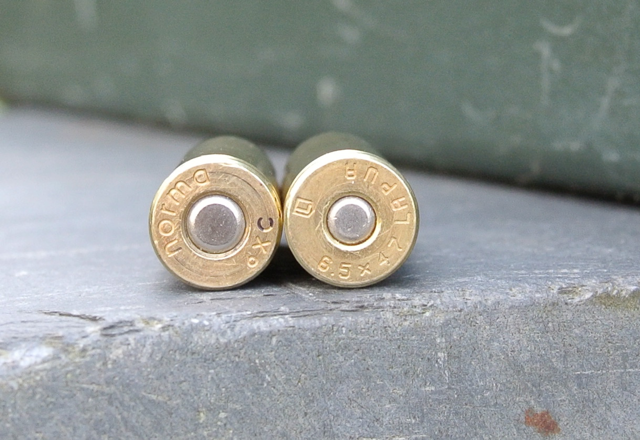
The 6XC also offers a small powder-capacity gain over the Smack but, can it burn that extra powder without over-pressure destroying the brass? That’s my quest – to find out if the 6XC is a viable ballistic replacement for the Smack.
The Build
My 6XC reamer is a Henriksen. Henrikson worked with David Tubb from the start when laying down the exact dimensions for the cartridge and my reamer is ground to give a more or less ‘no-turn’ neck with the factory Norma brass. A loaded round is measuring circa 0.270 and my chamber-neck 0.272 inches – maybe a little close for range work. When using un-turned factory brass you must be aware of slight variations and I therefore make a minimal ‘clean-up’ cut on the Norma necks, which ensures they are absolutely concentric and maintaining a clearance of not less than three thou. (0.003in). For F Class shooting, there is no advantage in going closer than this.
Running too tight a neck for F Class isn’t advisable – we shoot outdoors in all conditions, often with little opportunity to clean until the end of the day – when 50 or 60 rounds may have been fired. This is far from the controlled conditions we enjoy when shooting benchrest and I therefore like to make up a small neck-gauge, cut with the chamber reamer – see pic. As a precaution, I slip every loaded round into the gauge to ensure adequate clearance – as always, safety before convenience.
Load Development
If you read the Smack article, you will recall that we were able to claim some amazing muzzle velocities using Elcho 17 (Reloader 17) powder and the 105 grain Berger VLD bullet. I saw a mind-blowing 3400 fps on the chrono but, I know that using these velocities will destroy the brass in short time and I prefer to run at a more reasonable 3250 fps.
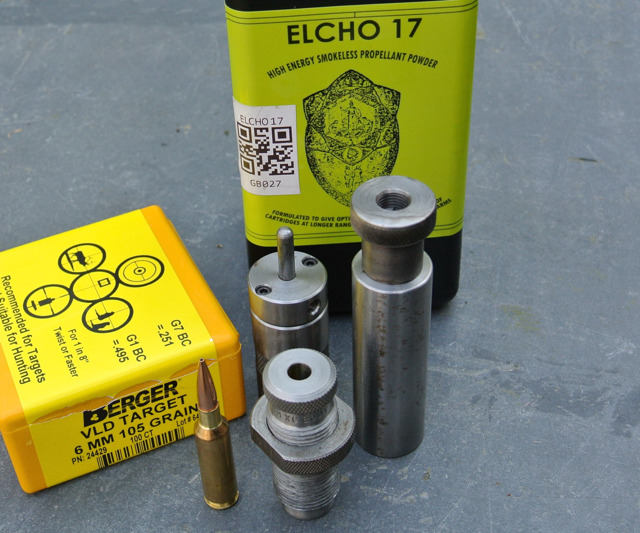
So, if the 6XC is to make the Smack redundant, it must at least achieve this velocity with the Smack’s sub. half MOA accuracy. For the record, Norma’s claimed velocity with their factory ammunition using the 105 gn Berger is 3114 fps, though a Swedish F Class-shooting acquaintance runs his 6XC at 1000 metres/sec (3280fps) using his home-loads.
I’m using a Benchmark barrel for this project. It’s a heavy profile – 1.25 inches at the breech tapering to an inch at the muzzle, with a finished length of 31 inches. The action is my BAT M bedded in one of Bill Shehane’s wood-laminate long-range benchrest stocks. I’m sticking with Elcho 17 – it works well in the Smack and an internet search reveals that its close neighbor, Reloader 17, is a popular powder with the 6XC on the other side of the pond.
For those not familiar with Elcho 17, this was one of the first powders offered by the new Reload Swiss Nitrochemie company. The Elcho17 is now re-packaged and re-named as RS60 which is in the area of (THOUGH NOT THE EQUIVALENT OF) Vihtavuori 550 or Hodgdon 4350.
I always follow the same procedure with a new barrel – find the pressure spike. In other words – maximum velocity. As 6XC inventor David Tubb states in his articles, he uses the ejector-pin hole in the bolt-face as a pressure indicator. When that shiny brass circle appears on the case-head you’ve exceeded maximum working pressure. Back-off your load or your brass will be scrap after a couple of firings.
My method is to load about 10 rounds, going up one third of a grain each time and shoot these one after another over the chronograph. My max. load was 44 grains – a nice caseful but, I didn’t get anywhere near to shooting that. My starting load was 40 grains and, at 40.9gn I hit the 3250fps that the Smack will easily deliver. 41.2gn gave me a ‘click’ when I opened the bolt – with the familiar bright ring on the case-head. It looks like we’ve found our max. load.
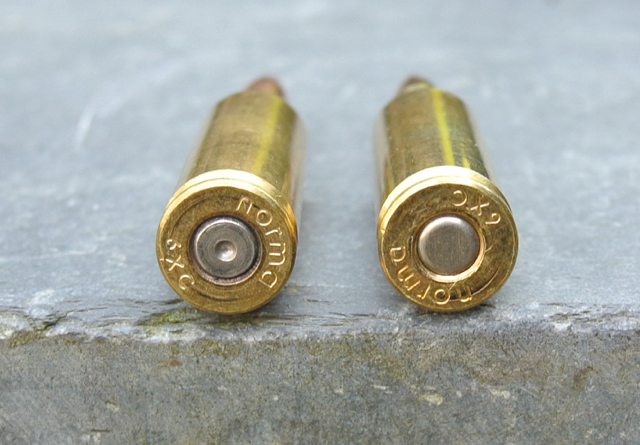
So, despite its case-capacity increase over the Smack, the extra volume isn’t useable – with RL17 at least. Performance is identical to the Smack – providing it will ‘group’ around 3250.
Yes, I did try a few other powders – Hodgdon 4350, Vit N150 and Vit N550 but none could match the Elcho 17 in delivering my target velocity.
AS ALWAYS, THESE LOADS WERE SAFE IN MY RIFLE – THEY MAY NOT BE SAFE IN YOUR RIFLE. THEY ARE NOT RECOMMENDATIONS, MERELY A REPORT ON WHAT I USED.
BE SAFE – WORK UP YOUR LOAD SLOWLY IN SMALL INCREMENTS.
With 105gn Berger VLD bullets, I got very good accuracy at 40.9gn – typically five-shots in a three-tenths of an inch group at 100 yards. The velocity-spread over five shots wasn’t too bad at 19fps and bolt-opening was nice and smooth. But, knowing that this particular Berger VLD often likes to ‘jump’ I tried both options – a ten-thou. jump and ten thou. into the lands – the jumping bullet gave tighter groups! Honestly, I prefer not to load into the lands for F Class anyway – if a “Ceasefire, remove bolts!” is called by the RO – a pulled bullet and an action full of powder can ruin your weekend!

Another way of checking for over-pressure is to measure the ‘swell’ of the case base after firing. A new 6XC case measures 0.468in. just above the extractor groove. After all my testing, (three firings) none measured more than 0.4695in. On new brass, my 40.9gn load produced an acceptable half-thou. swell and, after three or four firings, primer-pockets are still tight.
The Benchmark barrel now has around 60 rounds through it and it is shooting-in nicely. A small amount of initial coppering has almost disappeared and the bore feels nice and smooth with no rough spots. I’m almost ready to debut the rifle in competition – which just happens to be a 600 yard F Class shoot the week after Christmas.
Competition Debut
On the day of the shoot it was bitterly cold, with a westerly wind blowing diagonally across the range at 30 – 35 mph! A fellow 6XC shooter decided it would be a waste of ammunition and went home! I know from experience with the 6mm Smack that the 105 grain Berger can be a good performer at extreme ranges – providing it’s not too windy! Today, I could struggle. The best Open Class score posted was an 83 ex 100 with a 284Win. I was pleased to make second, just one point adrift.
My next outing is at 800 yards. Last time, using the Smack, I cleaned it with a 100 ex 100. The temperature is hovering around zero, winds are not too bad but it’s overcast with rain threatening.
I’ve not shot the 6XC beyond 600 yards so I don’t have a true 800 yard zero. My JBM Ballistic app tells me I will need another 12.7 MOA above my 100 yard zero with my 105 grain Berger VLD leaving the muzzle at 3250fps. Two MOA of right windage gives me a first round hit high at 12 o’clock – I need to come down a whole two MOA! My second sighter is line-cutter four and a small scope tweak puts me in the five-ring for my first to count.
Wind changes were gentle but I lost two points over my twenty shots. One was a line-cutter four but the other – shot 17 – was a really wide high ‘four’ that I couldn’t account for. I decided not to adjust and finished the shoot staying in the five and V bull. My 98.11v was top score, with two other shooters on 98 but with lower V bull count. All in all, a good debut for the 6XC at longer range.
As always, the sixes are a joy to shoot – I now don’t bother with a machine front-rest, I’m happy to use an FTR-style bi-pod – the negligible recoil means I can keep the target in view after I’ve pulled the trigger and a light push with the shoulder and a squeeze of the back bag has the crosshair back on my aimpoint.
Looking at my scope adjustment – 100 to 800 yards needing only about 10.5MOA, I’m suspecting that the Benchmark barrel has speeded-up slightly. According to my JBM ballistics prog. using a 105gn Berger VLD at 3250fps should be nearer 12.5. Next job – a chrono check.
More Testing
Sure enough, the 6XC was now clocking close to 3000 fps on a bitterly cold day. I’ve never really subscribed to the barrel speed-up theory but I’m beginning to believe it. One would assume that as a barrel smooths out it would, if anything, slow down but can it be that the smooth barrel against a smooth copper jacket actually increases friction and thus pressure?

With the first 1000 yard benchrest shoot of the season just a couple of weeks away, I decided to give the 6XC a run. Benchrest can often tell you things that F Class never will. Fortunately, it was a lovely day for the shoot with very light winds and I was pleased to record a 7.66 inch five-shot group – not the smallest of the day, but respectable. However, a blown primer indicated that pressure was still climbing, so back of the load and yet more testing.
Diet
Finally, a word about components. The Norma brass has proved to be every bit as consistent as Lapua – always an essential factor in an accurate cartridge. I’ve used Federal Large Rifle primers exclusively and I feel no urge to experiment with anything else. As always, the 105gn VLD Bergers lived up to expectation and I have no plans to try the Hybrid version. I had excellent results with the 105gn Lapua Scenar L bullet in the Smack but, pricewise the Bergers are cheaper……….
This is my first rifle with a Benchmark barrel (though I have just fitted one to my 6PPC benchgun and 22 Dasher) and I must say, I’m very pleased with it. It did copper-up a little when running-in but this pretty well disappeared after about 80 rounds. It now feels very smooth and cleans up easily.
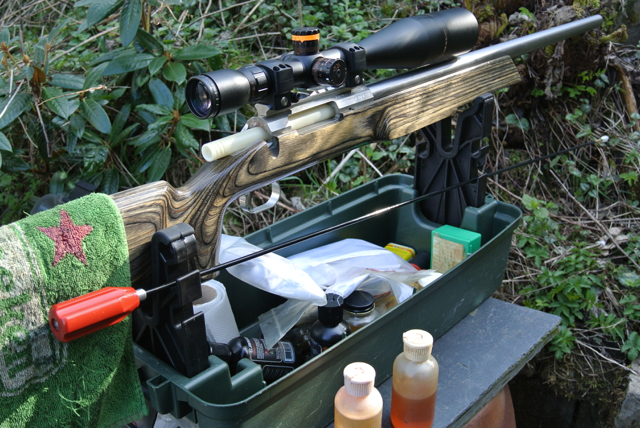
I thought that the 6mm Smack was the ultimate 6mm cartridge and I still do but, the 6XC has the attraction of shooting ‘out of the box’ brass without the need to fireform and neck-turn so will this force the Smack into retirement?
6mm Smack – Pros:
As accurate as any 6mm I’ve owned (6PPC excepted)
Small primer controls pressure better than a large primer and increases brass-life.
Fantastic m/v with the 105 bullet.
Readily available brass.
Cons:
Brass is expensive and fireforming is time-consuming and costly.
6XC Pros:
No fireforming
Off the shelf brass available – but only to order.
Cons:
Equal case capacity to the Smack but can’t use it.
Large primer doesn’t handle the pressure, so brass-life is short when running at max.
Struggles to match the Smack’s velocities.
Conclusion
Very little difference between these two cartridges but my Smack certainly wins the velocity race but the 6XC’s factory brass is a big plus. However, I’m still not totally happy with the 6XC and I feel there’s more to come, so look out for an update. If any readers are shooting a 6XC, I’ll be pleased to hear about your load data and velocities.


